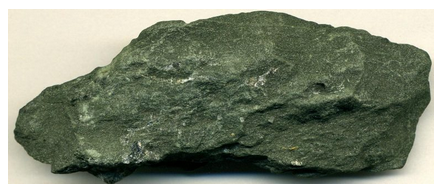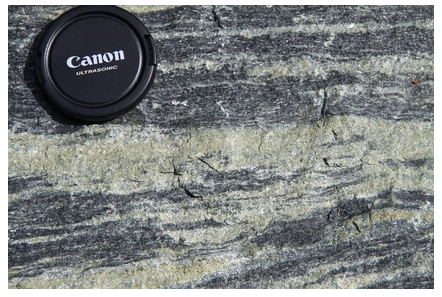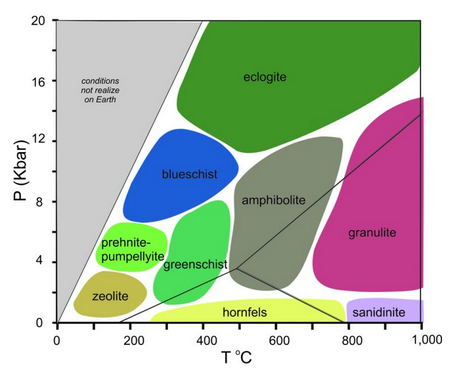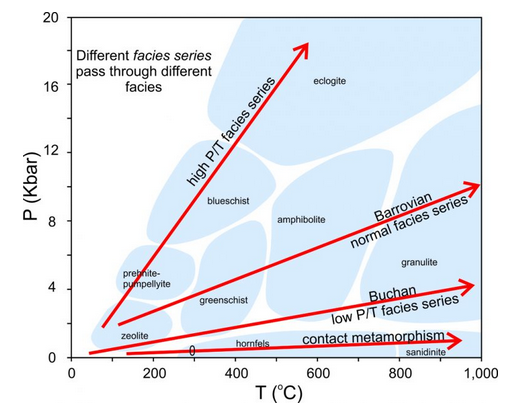8.7.2: Metamorphosed Mafic Rocks (Metabasites)
- Page ID
- 18628
| Common Minerals in Metabasites | |||||
| minerals | rock names | ||||
| low gradestrong>high grade |
zeolites prehnite pumpellyite Ca-rich plagioclase epidote chlorite actinolite hornblende garnet (almandine-pyrope)(Fe,Mg)3Al2Si3O12 biotite augite (pyroxene) orthopyroxene (enstatite) |
igneous greenstone amphibolite mafic gneiss mafic granulite |
|||
Metamorphosed basalts and other rocks of similar composition are commonly called metabasites. This is because, geologists once called basalts basic rocks. Compared with metasandstones and metapelites, metabasites are relatively poor in Al and Si and rich in Ca, Mg, and Fe. Many different minerals may form, and metamorphic reactions are complex. Plagioclase and augite are stable at all grades but other minerals are not. The most important metamorphic minerals are Ca and Mg silicates. Metabasites are generally more massive and less foliated than pelitic rocks, but at higher grades they do form schist and gneiss.
The table seen here lists the most common minerals in metabasites. Low-grade minerals are at the top of the table, and grade increases downward. Metamorphism often begins with the formation of zeolites, or of prehnite. These minerals may crystallize in vugs or cracks. They are secondary minerals in many igneous rocks, and form by hydration of feldspars when water flows through the protolith. Some petrologists do not consider these minerals to be metamorphic minerals, while others do.
The formation of greenstones is said by many to be the beginning of metamorphism. Greenstones are fine-grained, very low-grade metabasites that have a conspicuous light- to dark-gray or green color. The characteristic green color comes from fine-grained chlorite and epidote in the rocks. Greenstones may also contain Na-rich plagioclase (albite), quartz, carbonates, and zeolites. The photo below in Figure 8.65 shows a typical greenstone outcrop in northern Minnesota. Figures 8.34 and 8.35, earlier in this chapter, showed other examples.
At slightly higher grades, metabasites become greenschists, obtaining schistosity from parallel arrangements of the green amphibole actinolite and chlorite. Figure 8.66, below, shows a greenschist from the Homestake Gold Mine in Lead, South Dakota. Although hard to see, the specimen contains native gold near the bottom of the sample. If you enlarge the photo you can see the gold.
At still higher grade, chlorite, epidote, and actinolite break down by dehydration reactions, producing a specific kind of rock called an amphibolite. The photo in Figure 8.67 is an example. Amphibolites contain large grains of black hornblende and whitish plagioclase in subequal proportions. Garnet, biotite, and light-colored amphiboles such as anthophyllite or cummingtonite may also be present.



With even more metamorphism, mafic rocks may become mafic gneisses. At the highest grades, all amphiboles become unstable and dehydrate to produce pyroxenes. Assemblages including garnet and clinopyroxene, or orthopyroxene, are diagnostic of mafic granulites. Figure 8.10 earlier in this chapter, showed an example of a mafic granulite. Minor minerals at all grades include many that are present in mafic igneous rocks.
8.7.2.1 Metamorphic Facies
Pentti Eskola, a geology professor at the University of Helsinki, introduced the idea of metamorphic facies in 1920. He observed that the equilibrium mineral assemblage and texture of metabasites vary with pressure and temperature. Thus, rock mineralogy and texture record the conditions of metamorphism. Eskola defined facies as general ranges of pressure and temperature characterized by a distinct kind of metabasite.

Facies diagrams, such as the one in Figure 8.68, are similar to phase diagrams because they divide P-T space into small areas associated with specific minerals or mineral assemblages. The main differences between facies diagrams and phase diagrams are that facies diagrams involve many chemical components, the locations of different facies in P-T space are not precise, and we often do not know the exact reactions that relate one facies to another. Eskola originally identified eight facies. Other petrologists have divided some to more precisely represent pressure and temperature ranges. Each facies name comes from its most characteristic metabasite minerals or rock types. The table below summarizes key mineral assemblages for each facies.
| Key Mineral Assemblages in Mafic Rocks of Different Metamorphic Facies | ||
| kind of Metamorphism | metamorphic Facies | diagnostic Minerals |
| contact metamorphism | pyroxene hornfels | orthopyroxene + clinopyroxene + plagioclase |
| sanidinite | sanidine or tridymite or pigeonite or glass | |
| low-pressure metamorphism | zeolite | zeolites + quartz |
| prehnite-pumpellyite | prehnite or pumpellyite + quartz | |
| greenschist | chlorite, epidote, albite, quartz | |
| amphibolite | hornblende + plagioclase | |
| granulite | orthopyroxene or garnet + clinopyroxene + quartz | |
| high-pressure metamorphism | blueschist | glaucophane |
| eclogite | omphacite + garnet ± quartz | |
Zeolite minerals and clays characterize the zeolite facies. This facies represents the lowest grade of metamorphism; it is often hard to distinguish zeolite-facies metamorphism from diagenesis. As temperature rises, the zeolite facies gives way to the prehnite-pumpellyite facies, the greenschist facies, the amphibolite facies, and the granulite facies. Contact metamorphism produces two low-pressure, high-temperature facies, the pyroxene-hornfels facies and the sanidinite facies. The blueschist facies and the eclogite facies occur at high pressure.
Eskola based his facies names on minerals and textures of mafic rocks. The names of the facies are names of different kinds of metamorphosed mafic rocks. But petrologists use the same names when talking about rocks of other compositions. This leads to some confusion. The table above lists key mineral assemblages in mafic rocks, but the assemblages will never be present in rocks of other compositions. For example, pelitic or calcareous rocks do not form greenschists (green mafic schists) or amphibolites (mafic rocks dominated by amphibole and plagioclase) even when metamorphosed at conditions within the greenschist or amphibolite facies. In addition, for some rock compositions, several different mineral assemblages may be stable within a single facies. Further confusion arises because petrologists use some facies names in a more restricted sense, referring to particular rock types with important tectonic significance. Despite these problems, the facies concept provides a convenient way to discuss general ranges of pressure and temperature, and it receives wide use.
8.7.2.2 Facies Series

As a model for progressive metamorphism, petrologists consider different metamorphic facies series, the sequences of metamorphic rocks that would form in different metamorphic environments. The PT diagram in Figure 8.69 shows the most important of these series.
Rocks undergoing contact metamorphism experience only low pressure. They pass through the zeolite, prehnite-pumpellyite, low-pressure greenschist, pyroxene hornfels and sanidinite facies with increasing temperature. Such rocks are common anywhere magma has intruded shallow crustal rocks.
Rocks subjected to regional metamorphism during mountain building experience a significant increase in both pressure and temperature. They progress through the zeolite, prehnite-pumpellyite, greenschist, amphibolite, and granulite facies. Sometimes they follow a Buchan facies series (lower pressure) and sometimes they follow a Barrovian facies series (higher pressure).
Subduction carries relatively cool rocks to depth and high pressures. So, some rocks related to subduction zones follow the high P/T facies series, experiencing conditions in the zeolite, prehnite – pumpellyite, blueschist, and possibly eclogite facies. We find these rocks, typically, as blocks in fault contact with greenschist facies rocks. Petrologists have described blueschists from many places, but the two classic examples of the blueschist facies series are rocks of the Sanbagawa metamorphic belt of Japan and of the Franciscan Complex of California.


